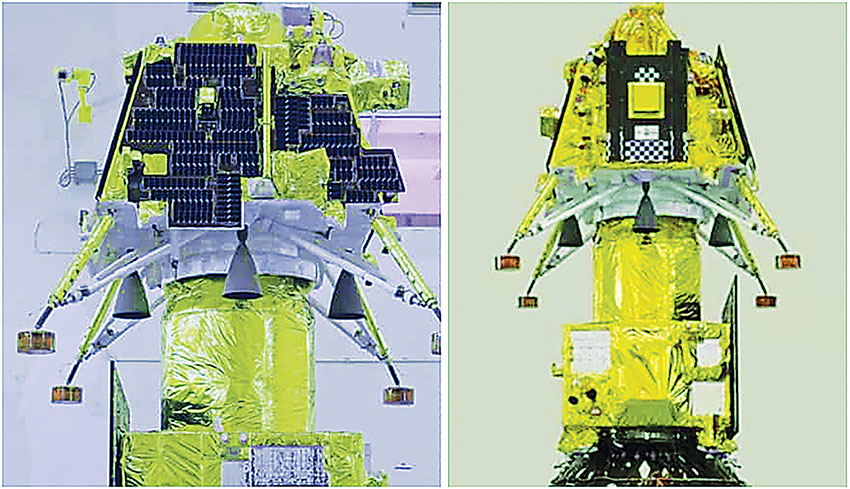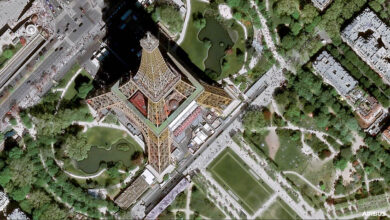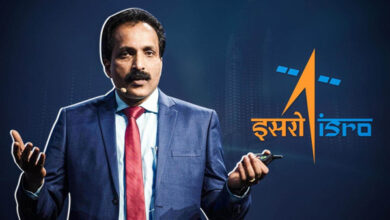Chandrayaan-3 Spacecraft Ready to be Encapsulated into Rocket, Says ISRO
- Earlier, the Chairman of ISRO had told that the launch window for Chandrayaan-3 on board the LVM3 rocket would be between the 12th and 19th of July. The launch window is the ideal period for a launch mission and any day within that interval would be chosen based on a host of factors.
- According to the most recent update, ISRO’s Chandrayaan-3 has been mated with the payload adapter. The payload adapter is a piece of hardware that connects a satellite to the rocket’s upper stage.
- ISRO shared pictures of its third Lunar Spacecraft Chandrayaan-3, which has now been mated with the payload adapter
Bangalore, June 28. Dr. S. Somnath, Chairman, ISRO said that the Chandrayaan-3 lander and rover would retain the names used in Chandrayaan-2. This implies that the Lunar lander will be known as ‘Vikram’, a tribute to Dr. Vikram A. Sarabhai, the brain behind the Indian space program.

Indicating steady progress towards a mid-July launch, the Indian Space Agency, ISRO shared pictures of its third lunar spacecraft Chandrayaan-3, which has now been mated with the payload adapter. The payload adapter is a piece of hardware that is used to connect the satellite (payload) to the upper stage of a rocket. Once a satellite is mated with the payload dispenser, it is then encapsulated within the payload fairing (nose cone of the rocket) and then stacked onto the launch vehicle.
Dr. S. Somanath, Chairman, ISRO said that the Chandrayaan-3 lander and rover would retain the names used in Chandrayaan-2. This implies that the Lunar lander will be known as ‘Vikram’, a tribute to Dr. Vikram A. Sarabhai, the brain behind the Indian space program. The rover will be known as ‘Pragyan’, a Sanskrit word that means wisdom. Launched in mid-July, the spacecraft would make a lunar landing towards the end of August, Dr. Somnath added.
India is undertaking its third lunar mission and second lunar landing attempt, after the previous mission Chandrayaan-2 could not perform the lunar soft landing. While barely two kilometres above the lunar surface, as it was approaching a vertical landing, ISRO lost contact with the then ‘Vikram’ lunar lander.
The lander had made a hard landing on the lunar surface, which it did not survive, thus leaving the lunar landing mission incomplete. However, the orbiter from Chandrayaan-2 continues to circle the moon and provide science data from its payloads. Therefore, Chandrayaan-3 will not be having an orbiter that is mounted with multiple science payloads. Instead, it will serve as a propulsion module that will help the integrated spacecraft reach the lunar orbit.
The Chandrayaan-3 orbiter weighs lesser than its predecessor. However, the payload mass reduced from the orbiter has been added to the Chandrayaan-3 lunar lander. This time around, ISRO had ruggedised the lander, placed larger solar panels for better power generation, added more fuel that can be used for manoeuvring, undertaken measures for failure tolerance and increased the scientific payloads.
The added mass on the lunar lander comprises more fuel, more ruggedization, measures for failure tolerance and strengthening of landing legs and increased scientific payloads, larger solar panels for better power generation,” Dr. S. Somanath, Chairman, ISRO said. He was responding to a question on whether the Chandrayaan-3 spacecraft would weigh lesser than its predecessor (which weighed around 3.6 tonnes or 3,600 kgs).
Earlier, the Chairman of ISRO had said that the launch window for Chandrayaan-3 on board the LVM-3 rocket would be between the 12th and 19th of July. The launch window is the ideal period for a launch mission and any day within that interval would be chosen based on a host of factors.
Given that the Indian lunar spacecraft would require around six weeks to travel from the earth to the moon (a distance of 3,84,000 kms), precise calculations are carried out and the launch time is determined down to the minute. When determining the time of launch, the mission planners consider the weather forecast, a flight path that is free of space debris, the dynamic position of the destination (with respect to Earth), the time taken to travel to the destination, the manoeuvres involved, the rocket being used, the purpose of the mission, the movement and impact of other heavenly bodies etc.
Queried about how confident the positive mission outcome of Chandrayaan-3 is, Dr. Somanath had said that he is always confident, but space is an unforgiving domain, where only rigorous testing and clear decision-making yield favourable results. Smilingly, making a mention of luck being involved, he said that “even luck comes out of hard work and the perseverance to do the right thing at the right time”.





